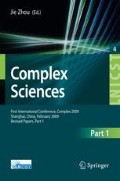Abstract
An urban microeconomic model of households evolving in a 2D cellular automata allows to simulate the growth of a metropolitan area where land is devoted to housing, road network and agricultural/green areas. This system is self-organised: based on individualistic decisions of economic agents who compete on the land market, the model generates a metropolitan area with houses, roads, and agriculture. Several simulation are performed. The results show strong similarities with physical Dieletric breackdown models (DBM). In particular, phase transitions in the urban morphology occur when a control parameter reaches critical values. Population density in our model and the electric potential in DBM play similar roles, which can explain these resemblances.
Access this chapter
Tax calculation will be finalised at checkout
Purchases are for personal use only
Preview
Unable to display preview. Download preview PDF.
References
Andersson, C., Lindgren, K., Rasmunssen, S., White, R.: Urban growth simulation from first principles. Physical Review E 66, 026204-1 -9 (2002)
Batty, M., Longley, P.: The fractal simulation of urban structure. Environment and Planning A 18, 1143–1179 (1986)
Batty, M.: Generating urban forms from diffusive growth. Environment and Planning A 23, 511–544 (1991)
Benguigui, L.: A new aggregation model. Application to town growth. Physica A 219, 13–26 (1995)
Benguigui, L.: A fractal analysis of the public transportation system of Paris. Environment and Planning A 27(7), 1147–1161 (1995)
Benguigui, L.: Aggregation models for town growth. Philosophical Magazine B 77, 1269–1275 (1998)
Benguigui, L., Czamanski, D., Marinov, M.: City Growth as a Leap-frogging Process: An Application to the Tel-Aviv Metropolis. Urban Studies 38, 1819–1839 (2001)
Bogoyavlenskiy, V.A., Chernova, N.A.: Diffusion-limited aggregation: A relationship between surface thermodynamics and crystal morphology. Physical Review E 61(2), 1629–1633 (2000)
Caruso, G., Peeters, D., Cavailhès, J., Rounsevell, M.: Spatial configurations and cellular dynamics in a periurban city. Regional Science and Urban Economics 37, 542–567 (2007)
Cavailhès, J., Frankhauser, P., Peeters, D., Thomas, I.: Where Alonso meets Sierpinski: an urban economic model of fractal metropolitan area. Environment and Planning A 36, 1471–1498 (2004)
Chikushi, J., Hirota, O.: Simulation of root development based on the dielectric breakdown model. Hydrological Sciences 43(4), 549–559 (1998)
Couclelis, H.: Cellular worlds: a framework for modelling micro-macro dynamics. Environment and Planning A 17, 585–596 (1985)
Frankhauser, P.: Aspects fractals de structures urbaines. Espace géographique 1, 45–69 (1991)
Li, B., Wang, J., Wang, B., Liu, W., Wu, Z.: Computer simulations of bacterial-colony formation. Europhysics Letters 30, 239–243 (1995)
Lu, Y., Tang, J.: Fractal dimension of a transportation network and its relationship with urban growth: a study of the Dallas - Fort Worth area. Environment and Planning B 31(6), 895–911 (2004)
Makse, H.A., Andrade, J.S., Batty, M., Havlin, S., Stanley, H.E.: Modeling urban growth patterns with correlated percolation. Physical Review E 58, 7054–7062
Makse, H.A., Havlin, S., Stanley, H.E.: Modelling Urban Growth Patterns. Nature 377, 608–612 (1995)
Mathiesen, J., Jensen, M.H., Bakke, J.O.H.: Dimensions, maximal growth sites, and optimization in the dielectric breakdown model. Phys. Rev. E 77, 066203 (2008)
Niemeyer, L., Pietronero, L., Wiesmann, H.J.: Fractal Dimension of Dielectric Breakdown. Phys. Rev. Lett. 52, 1033–1036 (1984)
Peruani, F., Solovey, G., Irurzuni, I.M., Mola, E.E., Marzocca, A., Vicente, J.L.: Dielectric breakdown model for composite materials. Phys. Rev. E 67, 066121 (2003)
Phipps, M.: Dynamical behavior of cellular automata under the constraint of neighborhood coherence. Geographical Analysis 21(3), 197–216 (1989)
Pietronero, L., Wissman, H.J.: Stochastic Model for Dielectric Breakdown. Journal of Statistical Physics 36(5,6), 909–916 (1984)
Sánchez, A., Guinea, F., Sander, L.M., Hakim, V., Louis, E.: Growth and forms of Laplacian aggregates. Phys. Rev. E 48, 1296–1304 (1993)
Schelling, T.C.: Dynamic Models of Segregation. Journal of Mathematical Sociology 1, 143–186 (1971)
White, R., Engelen, G.: Cellular automata and fractal urban form: a cellular modelling approach to the evolution of urban land use patterns. Environment and Planning A 25, 1175–1199 (1993)
White, R., Engelen, G.: Cellular dynamics and GIS: modelling spatial complexity. Geographical Systems 1, 237–253 (1994)
Witten, T.A., Sander, L.M.: Diffusion-Limited Aggregation, a Kinetic Critical Phenomenon. Phys. Rev. Lett. 47(19), 1400–1403 (1981)
Author information
Authors and Affiliations
Editor information
Editors and Affiliations
Rights and permissions
Copyright information
© 2009 ICST Institute for Computer Science, Social Informatics and Telecommunications Engineering
About this paper
Cite this paper
Cavailhès, J., Frankhauser, P., Caruso, G., Peesters, D., Thomas, I., Vuidel, G. (2009). Morphological Similarities between DBM and an Economic Geography Model of City Growth. In: Zhou, J. (eds) Complex Sciences. Complex 2009. Lecture Notes of the Institute for Computer Sciences, Social Informatics and Telecommunications Engineering, vol 4. Springer, Berlin, Heidelberg. https://doi.org/10.1007/978-3-642-02466-5_40
Download citation
DOI: https://doi.org/10.1007/978-3-642-02466-5_40
Publisher Name: Springer, Berlin, Heidelberg
Print ISBN: 978-3-642-02465-8
Online ISBN: 978-3-642-02466-5
eBook Packages: Computer ScienceComputer Science (R0)

